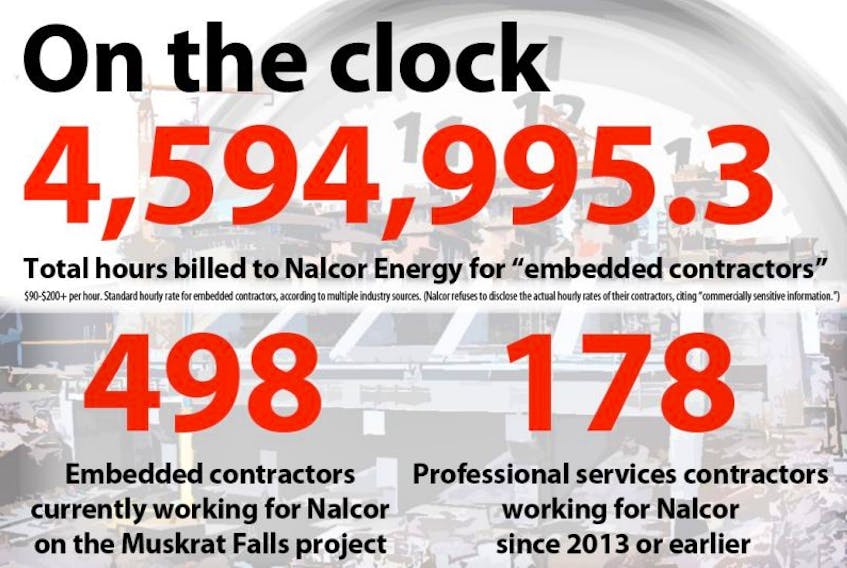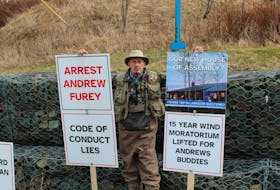Harrington has a Nalcor Energy email address, and he works full time as the project director for the Muskrat Falls hydroelectric construction project. He reports directly to Nalcor vice-president Gilbert Bennett.
But Harrington technically isn’t a Nalcor employee.
He’s one among hundreds of “embedded contractors” who do all manner of management and support work on the Muskrat Falls project.
Recently, The Telegram received responses to several access to information requests that shed light on how many professional services consultants are employed on the Muskrat Falls project.
Collectively, these contractors have invoiced Nalcor Energy for almost 4.6 million hours of work on the Muskrat Falls project.
Nalcor refused to disclose the hourly billing rates of contractors, citing a special “commercially sensitive information” provision in the Energy Corporation Act.
However, multiple sources with direct knowledge of the industry say that at the lowest end, these sorts of professional services contractors earn $90-$100 per hour. Among more specialized or experienced contract workers, the hourly rate can be anywhere from $190-$250 per hour, or even higher.
Currently, there are 498 active contractors working on the project. Over the past seven years, there have been nearly 1,000 such hourly contract workers doing various jobs.
These embedded contractors are not the tradespeople and construction workers who are actually building the Muskrat Falls dam and associated transmission lines.
The embedded contractors do accounting, human resources, management, health and safety, engineering and other such desk jobs.
In some cases, according to Nalcor CEO Stan Marshall, contractors have the authority to sign invoices and authorize payments to other Nalcor contractors.
Marshall said this kind of workforce is normal with megaproject construction, because the work is short-term and fluid, and many of the jobs are extremely specialized.
But a look at the data seems to indicate otherwise.
In one instance, a person identified as a “human resources manager” has been working continuously for Nalcor on a full-time basis since the fall of 2011. Figuring conservatively based on standard industry rates, this individual would cost Nalcor about $200,000 per year.
By comparison, at Confederation Building, directors of strategic human resource management earn between $105,000 and $127,000.
The documents provided by Nalcor in response to access to information requests also listed a total of 178 individuals currently working as embedded contractors for four years or more, including an accounts payable clerk, a supply chain manager, and a health and safety adviser.
Some of the hourly billings by embedded contractors raise eyebrows, such as the case of one member of the Muskrat Falls generation project delivery team. In 2015, that person invoiced for 3,167 hours of work on the project, which works out to 8.6 hours per day, every single day of the year — including weekends and holidays.
“I mean, someone should go in and check that, for sure. But I’m assuming it’s logged and verifiable,” Marshall said, when asked about the 3,167 hours.
“When you see something like that, you should go in and verify it, and I’m assuming that has been done.”
The Telegram attempted to contact both of these particular contractors, but did not receive responses by deadline.
When asked whether this system of embedded consultants was the least-cost way to run the Muskrat Falls project, Marshall said, “I can’t say.”
One industry source, who has done contract work for the Muskrat Falls project, said this system is a symptom of the disorganization at Nalcor when it comes to Muskrat Falls.
“It shows an organization that was not in any way prepared or capable of executing this project,” the source said.
“It’s absurd. Imagine if the government did this in any other department. Just imagine.”
Another source, with knowledge of the internal workings at Nalcor, estimated that roughly 90 per cent of the people managing the Muskrat Falls project are contractors who are not directly employed by the company.
“I could not name one single employee for the Lower Churchill project,” the source said. “If you told me to find one, I don’t think I could find a single one that’s not a contractor.”
Marshall said he isn’t sure whether embedded contractors are counted as part of Nalcor’s published employment statistics about the Muskrat Falls project.
He said that since most of the embedded contractors were hired before he became CEO in 2016, he’s not certain whether they were hired through a tender or a sole-source contract.
“I don’t know. It’s before my time. All I know is that I deal with the contracts that are coming up for renewal.”
Nalcor refused to disclose the names of the companies that the embedded contractors are actually working for, citing personal privacy concerns. As such, it’s impossible to say how many of the workers are employed by large staff augmentation firms — known in the industry as “body shops.” Those companies typically take a percentage of the hourly rates, between 10 and 30 per cent, according to one source.
But some of the contractors are employees of one-person corporations, so they pocket all of the vastly inflated hourly wages, although they’re responsible for Canada Pension Plan contributions and other benefits costs.
Reached for comment, Public Utilities Board consumer advocate Dennis Browne said the revelations about embedded contractors further underscore the belief that Nalcor has been given free rein on the Muskrat Falls project, with no meaningful oversight.
“Only with a full public inquiry under the jurisdiction of the Public Inquiries Act and presided over by a justice of our Supreme Court who has powers of subpoena, and can subpoena witnesses from other Canadian jurisdictions, will there ever be light shed on what has really transpired here,” Browne said.









